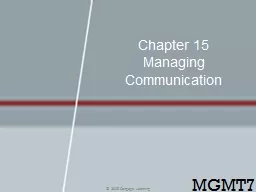

2015 Cengage Learning MGMT7 2015 Cengage Learning 151 explain the role that perception plays in communication and communication problems 152 describe the communication process and the various kinds of communication in organizations ID: 726327
Download Presentation The PPT/PDF document "Chapter 15 Managing Communication" is the property of its rightful owner. Permission is granted to download and print the materials on this web site for personal, non-commercial use only, and to display it on your personal computer provided you do not modify the materials and that you retain all copyright notices contained in the materials. By downloading content from our website, you accept the terms of this agreement.
Slide1
Chapter 15Managing Communication
© 2015 Cengage Learning
MGMT7Slide2
© 2015 Cengage Learning
15-1 explain the role that perception plays in communication and communication problems
15-2
describe the communication process and the various kinds of communication in organizations
15-3
explain how managers can manage one-on-one communication effectively
15-4
describe how managers can manage organization-wide communication effectivelySlide3
Perception
The process by which individuals attend to, organize, interpret, and retain information from their environments. © 2015 Cengage Learning
15-1Slide4
Basic Perception Process
© 2015 Cengage Learning
15-1Slide5
Perception Problems
Selective perceptionClosure©
2015
Cengage Learning
15-1Slide6
Perceptions of Others
Attribution theory: we all have a basic need to understand and explain the causes of other people’s behaviorinternal attributionexternal attribution
Defensive bias
Fundamental attribution theory
©
2015
Cengage Learning
15-1Slide7
Defensive Bias and Fundamental Attribution Error
© 2015 Cengage Learning
15-1Slide8
Self-Perception
Self-serving biasThe tendency to overestimate our value by attributing success to ourselves and failures to others or the environment©
2015
Cengage Learning
15-1Slide9
The Interpersonal Communication Process
15-2
©
2015
Cengage LearningSlide10
Noise
© 2015 Cengage Learning
Anything that interferes with the transmission of the intended message.
The sender isn’t sure what message to communicate.
The message is not clearly encoded.
The wrong communication channel is chosen.
The message is not received or decoded properly.
The receiver doesn’t have the experience or time to understand the message.
15-2Slide11
Formal Communication Channel
The system of official channels that carry organizationally approved messages and information.
Downward communication
Upward communication
Horizontal communication
15-2
©
2015
Cengage LearningSlide12
Informal Communication Channel
The transmission of messages from employee to employee outside of formal communication channels. © 2015 Cengage Learning
15-2Slide13
Grapevine Communication Networks
15-2
©
2015
Cengage LearningSlide14
Managing Grapevines
Worst thing to do is withhold informationKeep employees informed about possible changes and strategiesDo not overlook the grapevine as a tremendous source of information and feedback
©
2015
Cengage Learning
15-2Slide15
Coaching
Communicating with someone for the direct purpose of improving the person’s on-the-job performance.Mistakes managers make
Waiting for a problem before coaching
Waiting too long before talking to employee about problem
©
2015
Cengage Learning
15-2Slide16
Counseling
Communicating with someone about non-job-related issues.Managers should not be cliniciansDiscuss specific performance problems
Listen if the employee shares personal issues
Recommend that employees call the company’s Employee Assistance Program (EAP)
©
2015
Cengage Learning
15-2Slide17
Nonverbal Communication
Any communication that doesn’t involve words; almost always accompanies verbal communication and may either support or contradict it. Kinesics
Paralanguage
©
2015
Cengage Learning
15-2Slide18
Communication Medium
The method used to deliver a message.Oral communicationWritten communication
©
2015
Cengage Learning
15-3Slide19
Oral Communication
Managers generally prefer oral communication over written because it provides opportunity to ask questions. A rich communication medium
©
2015
Cengage Learning
15-3Slide20
Written Communication
Well suited for delivering straightforward messages and informationEmail is fastest growing communication form in organizations because of convenience and speed.
©
2015
Cengage Learning
15-3Slide21
Listening
Most people are terrible listeners, retaining only about 25% of what they hear.About 45% of total communication time is spent listening.
©
2015
Cengage Learning
15-3Slide22
Active Listening
© 2015 Cengage Learning
Assuming half the responsibility for successful communication by actively giving the speaker nonjudgmental feedback that shows you’ve accurately heard what he or she said.
Clarify responses
Paraphrase
Summarize
15-3Slide23
Clarifying, Paraphrasing, and Summarizing Responses for Active Listeners
15-3
©
2015
Cengage LearningSlide24
Empathetic Listening
© 2015 Cengage Learning
Understanding the speaker’s perspective and personal frame of reference and giving feedback that conveys that understanding to the speaker.
Show desire to understand
Reflect the speaker’s emotions
15-3Slide25
Giving Feedback
Destructive feedbackConstructive feedback
©
2015
Cengage Learning
15-3Slide26
Giving Constructive Feedback
ImmediateSpecificProblem-oriented©
2015
Cengage Learning
15-3Slide27
Improving Transmission
EmailOnline discussion forumsTelevised/videotaped speeches and meetings
Voice messaging
©
2015
Cengage Learning
15-4Slide28
Establishing Collaborative Discussion Sites
15-4
©
2015
Cengage LearningSlide29
Organizational Silence
Withholding information about organizational problems or issues.Occurs when employees believe that telling management about problems won’t make a difference, or that they’ll be punished.
©
2015
Cengage Learning
15-4Slide30
Improving Reception
Company hotlinesSurvey feedback Frequent informal meetings
Surprise visits
Blogs
©
2015
Cengage Learning
15-4Slide31
Plant Fantasies
Why would Teresa Carleo and Steve Martucci favor face-to-face communication over email when dealing with customers?
Why would
Carleo
and
Martucci
prefer to use electronic communication methods for certain types of communication within the company?
In the video,
Carleo
says that she worries that at times she communicates too much. What steps could she take to confirm that her messages are being heard and understood by others?
©
2015
Cengage Learning